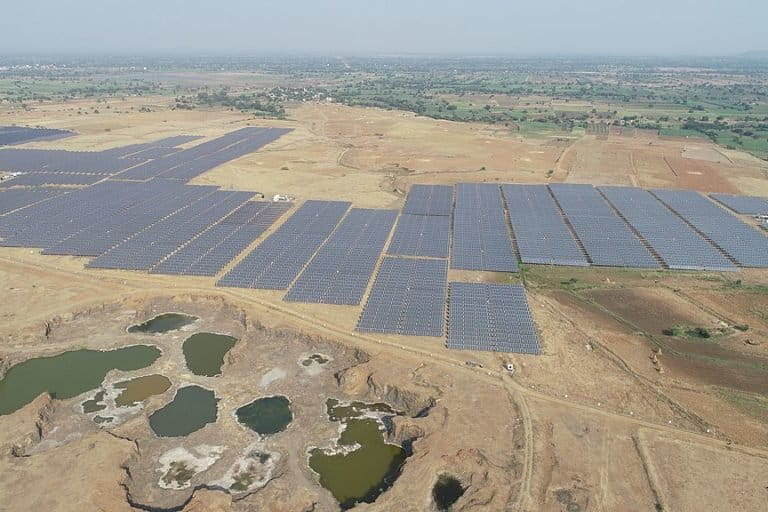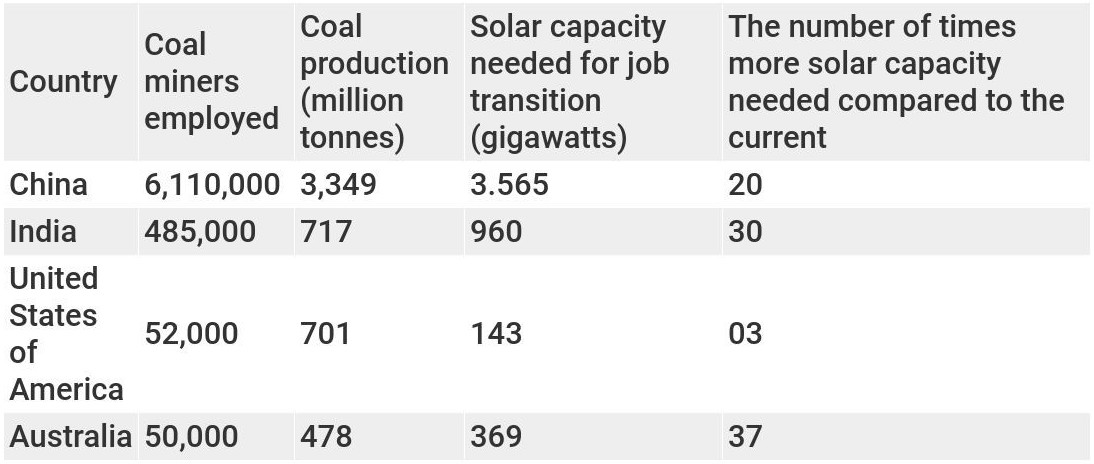- A latest study has found that India would need to install about 1,000 gigawatts of solar power, about 30 times higher than its present solar power, to transition about 500,000 people involved in coal mining.
- Phasing out of coal-based power is one of the major targets of global climate agreements. The study emphasised that solar power has greater suitability than wind for replacing local coal mining jobs.
- For the transition of people involved in coal mining and related work, the study said that the policymakers will need to not just look at not just renewable energy sector jobs but alternate jobs as well.
Climate change-induced disasters are a new normal across the world. A magic pill that is prescribed to combat these impacts is complete phasing out of coal and transitioning to renewable power. A latest study has now revealed that India would need to scale up its current solar capacity to nearly 30 times, about 1,000 gigawatts, to transition about half a million people directly working in coal mines.
The study, ‘Solar has greater techno-economic resource suitability than wind for replacing coal mining jobs’, published in the journal Environmental Research Letters in January 2020, is a collaborative work between researchers from the University of British Columbia, Canada and the Chalmers University, Sweden under a project funded by the Norwegian Research Council.
The study focused on India, China, the United States and Australia – countries that represent 70 percent of global coal production. Coal mining directly employs over seven million workers and benefits millions more through indirect jobs globally. Repeated studies have advocated for cutting down coal production to tackle climate change. But the question remains whether those employed in coal mining can be rehabilitated in jobs in the solar and wind power industry.
The four-country study evaluated the local solar and wind capacity required in each coal mining area and the scale of renewable energy deployment required to enable all coal miners to transition to solar or wind jobs. It focused mainly on solar and wind jobs because they represent over half of today’s renewable power jobs.
Phasing out of coal-based power is also one of the major targets of climate agreements. At the Paris Agreement in 2015, the world agreed to make efforts to limit the increase in global average temperature to well below two degree Celsius above pre-industrial levels and to try its best to limit the increase to 1.5 degree Celsius. However, to meet the 1.5 degree Celsius climate target, coal’s share in global energy supply should decline between 73-97 percent by 2050. But that would mean a near elimination of coal mining jobs.
The study showed that except for the U.S., each coal mining area would require several gigawatts (GW) of solar or wind power capacity locally to enable all coal miners in these areas to transition to solar or wind jobs. It stressed that deploying solar and wind power may not be techno-economically feasible in all coal mining areas due to low suitability of the resource.
“It is clear that while solar has greater techno-economic resource suitability than wind for replacing local coal mining jobs, this suitability doesn’t exist in all coal mining areas,” the study said.
For instance, in China, only 29 percent of the coal mining areas have suitable solar power resources. In India and Australia nearly all coal mining areas are suitable for solar power, while around 62 percent of the coal mining areas in the U.S. are suitable for solar power.
It stated that the wind power suitability in coal mining areas is low in all four countries at less than seven percent of coal mining areas having suitable resources. “Less than five percent of coal mining areas are suitable for both solar and wind power generation,” said the study.
It emphasised that even for solar, countries would need to substantially increase their current installed solar capacity – from three times in the U.S. to 37 times in India – to transition only those coal miners who live in suitable solar areas to solar jobs.
“Our study shows that in general, wind industry jobs are not a feasible replacement for local coal mining industry jobs in any of these countries. There isn’t enough wind around coal mines. Solar industry jobs may be an option in India and Australia’s coal mining areas, and perhaps the U.S. However, there isn’t enough sun in most Chinese coal mining areas for this to be a viable option,” Sandeep Pai, a researcher at the Institute for Resources, Environment and Sustainability at the University of British Columbia and the lead author of the study, told Mongabay-India.
The study also said that answering this question is significant to ensure a ‘just transition’ and to overcome possible politically-powerful coal mining interests so that they do not impede energy transitions.
It is because historic analysis of the coal industry declines show that coal miners do not migrate when they lose their jobs. For instance, in the US, coal miners helped support the rise of President Donald Trump, who, once elected, pulled the US out of the Paris climate agreement.

India needs over 30 times of present solar power to rehabilitate people involved in coal mining
In India, the study looked at states like Chhattisgarh, Jharkhand, Odisha, Telangana and Madhya Pradesh, which account for over 85 percent of the country’s coal production. It found that around each coal mine nearly two gigawatts of solar power would need to be installed to absorb all coal miners working in the mines.
At present, about 485,000 coal miners are involved in India in the production of over 700 million tonnes of coal annually. There are also a large number of indirect jobs connected with the broader coal mining industry. Like, there are millions of people in coal mining towns across India, who run local tea stalls shops, restaurants, and grocery stores and thus if the coal industry declines, the survival of all these jobs will be difficult.
The study revealed that, at the regional level, all key coal-producing states are suitable for solar power generation, but almost no coal mining areas in India and its key coal-producing states are suitable for wind-power generation, because of the paucity of the wind resources.
The study’s lead author Sandeep Pai explained that “there is a complete mismatch between areas in India suitable for wind power and areas where coal mining is happening.” “Thus, creating wind jobs are not really an option in the coal mining area in India,” he said.
This means that for providing solar jobs for coal miners working in 500 operating mines in India, the country would have to scale up the current solar capacity substantially to almost 1,000 GW which is more than 30 times the current capacity. The key challenge is that this would need to be done in a few major coal-mining states.
At present (till December 31, 2019), India has an installed solar capacity of 33.73 GW India has a target of 175 GW of renewable power by 2022 and of that 100 GW is from solar power.
“Even if the government wanted to do it and there is energy demand in the future, building 960 GWs of solar capacity is a huge ask. One of the biggest challenges would be acquiring land. Although Coal India has large tracts of abandoned land, it might not be enough to create such a capacity,” said Pai.

Is the transition of coal-based jobs to renewable jobs viable?
The study stated that the scale of deployment of renewable energy required raises serious questions about the viability of a transition path that depends solely on local renewable energy jobs for coal miners.
“This is true at both the local level where several GWe of installed capacity would be required per coal mining area and in aggregate where several times national capacity would be required just for absorbing mining jobs in areas suitable for renewable energy deployment. This means, in practical terms, not all coal miners may be able to transition to solar or wind jobs locally even in areas with suitable resources,” said the study.
There are numerous international organisations like the International Labour Organisation and International Renewable Energy Agency which claim that green jobs (like solar and wind jobs) can replace fossil fuel industry jobs. For instance, the ILO estimates that around 24 million green-jobs including renewable energy jobs, could be created worldwide by 2030 if governments take action to limit warming to two degree Celsius.
Another report by the International Renewable Energy Agency’s (IRENA) said that renewable energy could employ more than 40 million people by 2050. It said that total energy sector employment can reach 100 million by 2050, up from around 58 million today should the international community utilise its full renewable energy potential.
“While solar jobs could be the answer in some coal mining areas, policymakers would need to focus on a variety of industries including both renewables and non-renewables to help coal miners make an employment transition locally,” the study said. The study said that one innovative solution would be to provide coal miners with alternate jobs.
“The government needs to present an example of moving people from fossil fuel-based industry to renewables. Right now, the government is not targeting the people involved in the fossil fuel-based industry while running these skill programmes. Moreover, they need to look beyond renewable power sector jobs and reskill them in terms of alternate jobs,” Rakesh Kamal, an independent climate negotiations expert and host of the podcast, Climate Emergency, told Mongabay-India.
Sandeep Pai also cautioned that “globally, researchers and policymakers need to think beyond renewable energy jobs for fossil fuel workers.”
CITATION
Pai, S., Zerriffi, H., Jewell, J., & Pathak, J. (2020). Solar has greater techno-economic resource suitability than wind for replacing coal mining jobs. Environmental Research Letters.
Banner image: A solar engineer in the solar-powered village of Tinginapu, Odisha. Photo by Abbie Trayler-Smith/Panos Pictures/Department for International Development.
